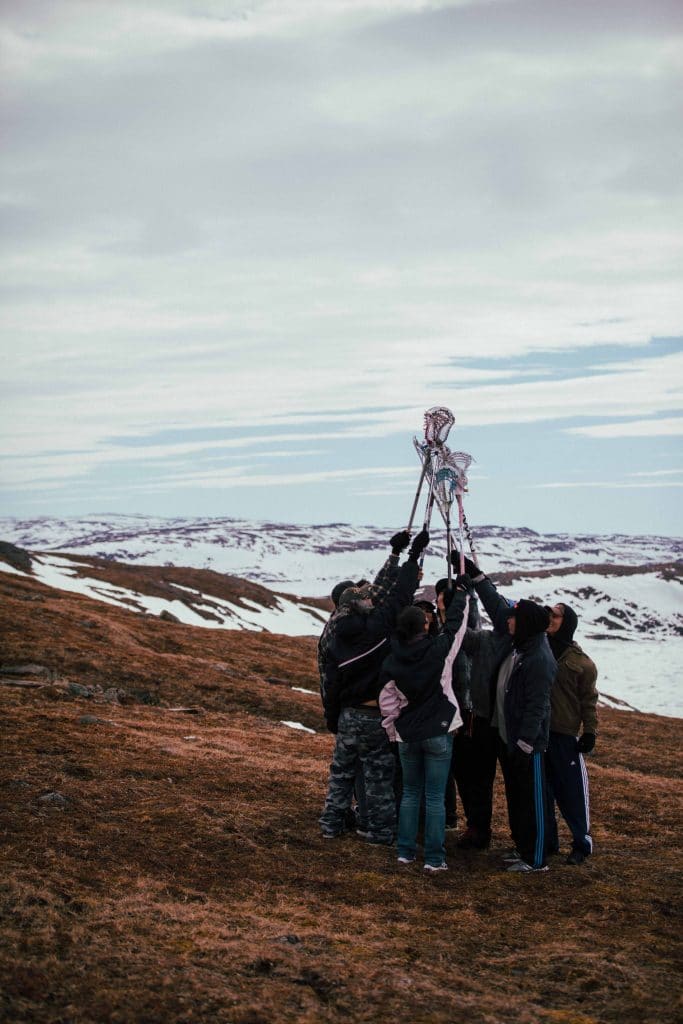Trigger warning: this article contains references to suicide, abuse and addiction.
If there is one pervasive narrative in Western film and media, it’s the underdog story. Usually centered around sports, a team of troubled youths band together under the guidance of a wise, if slightly jaded, teacher who has found themself stuck in a community they can’t wait to get out of. These stories are inspirational, aspirational, and above all, a reminder of how obsessive humans become if you give them a team to root for. But there is an important truth to films like this, and recent release The Grizzlies showcases that perfectly.
The Grizzlies follows the Kugluktuk community and the lacrosse team formed by a group of Inuit students with the help of teacher Russ Sheppard (played by Ben Schnetzer). Inspired by true events, the film is brutally honest in its depiction of the rural town, which held the highest rate of suicide in North America. The community is isolated, with expensive food and transport meaning many students need to skip school in order to hunt and provide for their families. The young people adopt the habits of their parents, who are deeply affected by intergenerational trauma caused by colonialist acts of control over them and their culture. But this is simply because there is little else for them to do.
When Sheppard arrives, he is oblivious to the local culture, and ill-equipped to teach a group of kids who are severely affected by ongoing trauma and grief. For any aspiring educators, the first 30-minutes of The Grizzlies could be used as a crash course in how not to teach! In conversation with director Miranda de Pencier, she reveals that this was an accurate depiction of the real Sheppard, who was able to learn from the Kugluktuk community during his time as a teacher there. In the film, as Sheppard connects with the community’s issues, he also realises he can provide an outlet for the students by teaching them lacrosse, giving the young people something to drive and unite them.
While the story seems familiar, there is an honesty and respect deeply rooted in the film’s telling of it, a sense of extra care and consideration in approaching the issue of youth suicide in indigenous communities. Embedded within this, is a recurring comedic style that manages to lighten the load of the heavy subject matter without compromising it. Much of the humour is related to Sheppard’s cultural incompetency in working with Inuit students, with much of the film’s heart coming from his growing connection to the community as he opens himself up to becoming a part of it. The film maintains a documentary-esque feel, keeping the story grounded in realism, with many scenes based directly on true events.
De Pencier expressed how this sense of realism came from collaborating with Inuit people, preferencing their voices at all levels of production of The Grizzlies. She became involved with the project ten years ago, and acknowledges that as a white woman, she could not have given the story justice without working closely with Inuit people with lived experiences in these communities. With over 90% of the film’s cast and over 30% of the crew having an Inuit background, the production created opportunities for local employment in rural Canadian communities, providing paid training and mentorship. The film’s soundtrack, which uses music by contemporary Inuit artists, resonates on screen as the young characters develop a positive youth culture through sports. This is a movie that could guide film-makers in every context working with indigenous peoples, including in Australia where Aboriginal and Torres Strait Islander peoples are still often left to the side in the telling of their own narratives.
While not the same, there are many echoes between the effects of colonialism on Inuit people in North America and Aboriginal and Torres Strait Islander people in Australia, so much so that this film has the potential to add to Australia’s ongoing conversation about reconciliation with Indigenous peoples. One such similarity de Pencier notes is that of applying deficits (such as violence or addiction) to marginalized Indigenous peoples, and the importance of showcasing systemic issues without reducing people to them: “To tell a story like this authentically, you have to talk about the issues… You need to show those problems exist, also to show the power of how profound [The Grizzlies] program was on these kids lives and also how amazing they were and how resilient they were to make a change.”
It is poignant today to see that this program did succeed in having a positive impact on a group of young people disproportionately affected by youth suicide, with the Grizzlies evolving from lacrosse to soccer, basketball and table tennis as well, and many original members becoming active leaders in Kugluktuk. As a student-led program, it is a continuing opportunity to empower young people to take action and responsibility, to contribute to their community, to create a space for themselves to heal and share passion and love. This is a sports movie that could, genuinely, be said to be inspirational, aspirational, and above all, a reminder to seek joy with each other even in difficult times.
“It’s okay to feel sad… and still seek joy and have goals and reach high and go for it.” – Miranda de Pencier
The Grizzlies is in cinemas now.
If the content of this article was distressing for you, please seek help from Lifeline at 13 11 14.




